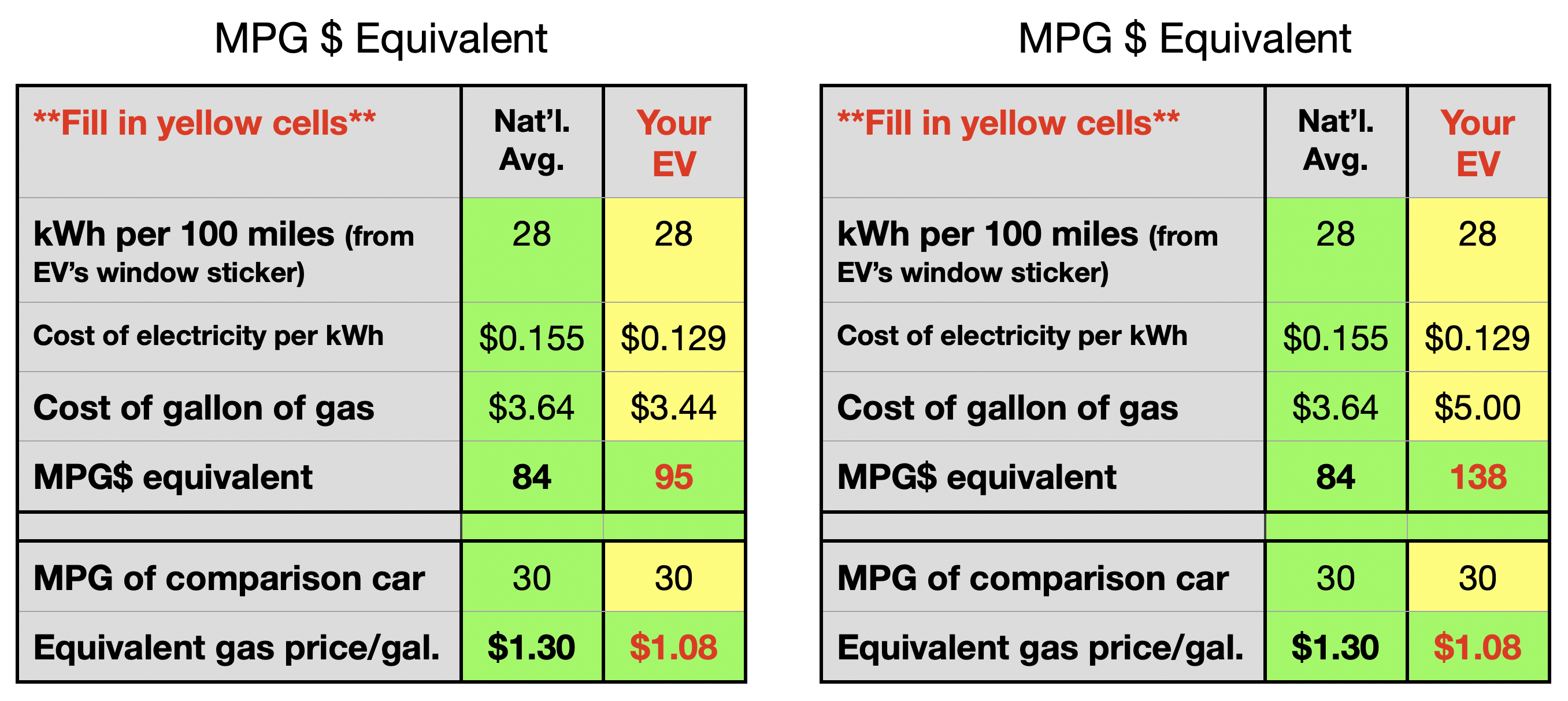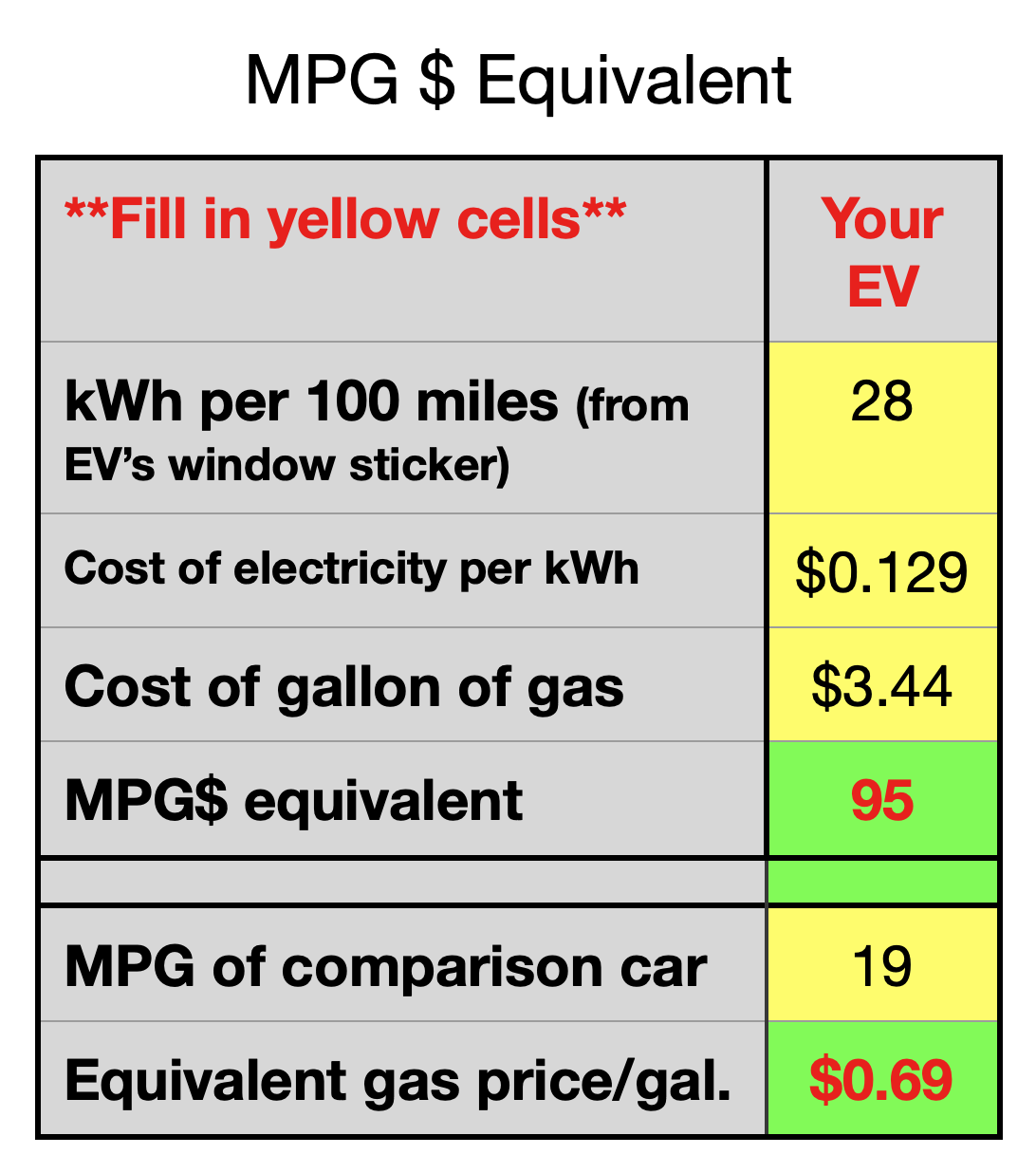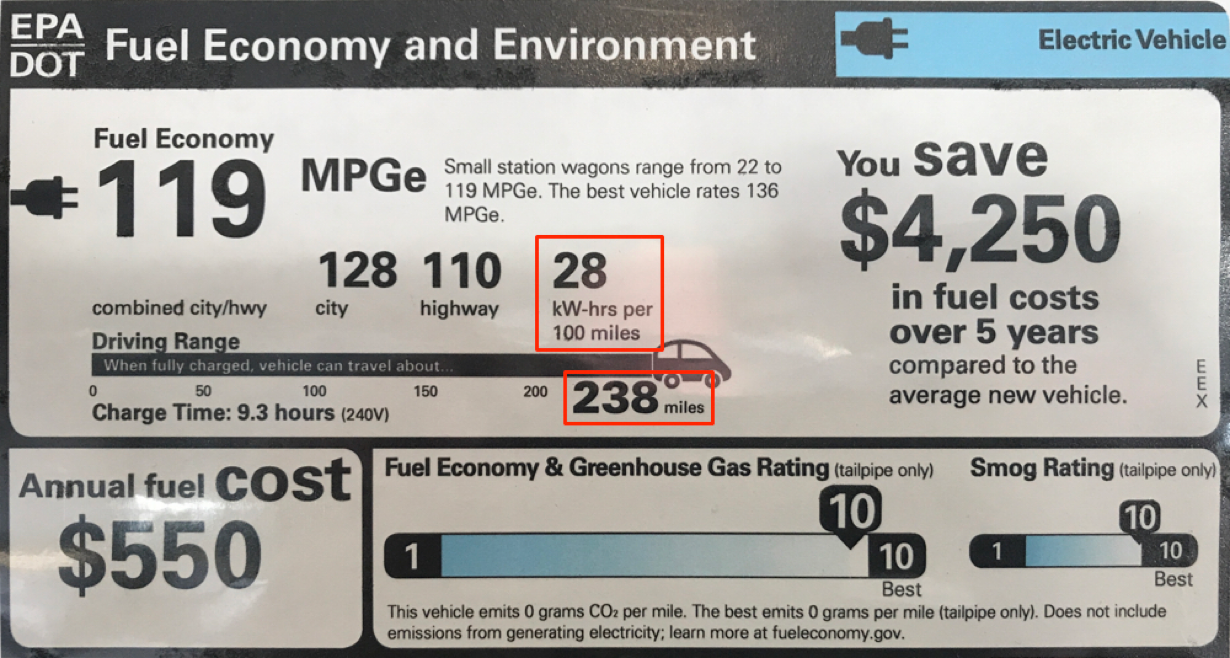New vehicle window stickers have an EPA section. It’s where you usually look for the MPG or “Miles Per Gallon” rating of a vehicle. Since electric vehicles use electricity as “fuel,” how do you make that comparison? Well, the EPA came to the rescue by creating MPGe or “Miles Per Gallon equivalent.”
It is important to understand the information presented in the EPA section of the window sticker to really understand how an electric vehicle compares to a gasoline- or diesel-powered vehicle with regards to the cost of driving it.
First, some nerdy stuff: (jump ahead three paragraphs if you’re not a nerd like me)
When considering how to compare gasoline to electricity we have to understand how much energy is in each type of “fuel.” The unit used is called a British Thermal Unit (or BTU). You’ve probably seen BTUs mentioned on things like your home’s air conditioner. Specifically, one BTU is the amount of heat it takes to raise the temperature of one pound of liquid water by 1° Fahrenheit (F) at the temperature that water has its greatest density (approximately 39° F).
Various grades of gasoline and diesel contain between 120,214 to 138,700 BTUs. A killowatt hour (kWh) of electricity contains 3412.14 BTUs. That’s about a 37.9 to 1 ratio, averaging across the fossil fuel types. Due to the range of BTUs in the various forms of gasoline, the EPA determined that the balance between gasoline and electricity is about 33.7 to 1.
With me so far? No worries, we’re past most of the nerdy stuff now.
Do you find yourself pondering the BTUs consumed by various vehicles, as they cruise down the road? Of course not! No one but an EPA scientist does. What you probably care about is this burning question:
“How much money does it cost me to drive down the road?”
Remember when the war in Ukraine started? The price of gasoline went up to a national average of over $5.00 per gallon. In Texas, most of us can select our electricity provider and lock in a rate for years. I locked my rate in for three years, when it was relatively low in price, so wars, hurricanes, etc. have no impact on the cost of my EV’s “fuel.” That’s a huge advantage during times of instability. Those fluctuations make it impossible to put the comparative cost of driving an electric vehicle down the road on a window sticker, because that cost is always changing. Window stickers can’t react to changes in both fuel prices (electricity and gasoline). Those price fluctuations make MPG$e a moving target, but I have a solution for you (if you charge at home or know the cost per kWh that public chargers in your area charge)*. It’s an MPG$e (Miles Per Gallon Dollar equivalent) calculator that you can load into your smartphone, tablet, laptop or desktop computer. It’s a very simple spreadsheet and is available in Microsoft Excel or Apple Numbers format.
Here’s two images of what the spreadsheet looks like. There are four numbers you provide:
- the number of “kW-hours per 100 miles” from the EPA section of any electric vehicle’s window sticker (see image above – in that image, the value is 28, and is in the upper red box)
- the cost you pay for a kWh of electricity at your home and
- the cost of a gallon of gasoline in your area.
- the MPG rating of a gasoline or diesel powered vehicle you wish to compare to the EV.
Once you enter those four values into the four yellow cells, you see the dollar equivalent of MPG vs. MP-kWH. The resultant MPG$e is in the “MPG$ equivalent” row’s right cell, in red. Notice the left version of the spreadsheet has an MPG$e of 95 and the right spreadsheet has an MPG$e of 138. That’s a huge difference and the only thing that’s different is the price of a gallon of gasoline. When the price of gasoline is lower, MPG$e is also lower. When the price of gasoline is higher, MPG$e is higher, as well. Also notice that the EPA’s estimate for MPGe, on the window sticker is 119. Based on the cost of electricity and gasoline, in my area, the EPA’s estimate is inaccurate (for the EV whose sticker is shown above). When gasoline costs $3.44 per gallon and electricity costs 12.9¢ per kWh, MPG$e is 95, but when gasoline is $5.00, MPG$e is 138.
That’s why a static, printed window sticker can’t tell the whole story.

The lowest two rows of the spreadsheet shows a different comparison of the EV to a gasoline or diesel powered vehicle. In that area of the spreadsheet, it shows what gasoline or diesel would have to cost per gallon in order to have the same fuel cost per mile as the EV. As the image shows, if the vehicle you’re comparing to the EV has an MPG of 30, gasoline would have to cost only $1.08 per gallon for the gasoline or diesel vehicle to have the same fuel cost per mile as the EV you’re using for comparison. Also notice the that theoretical price per gallon does not change, even if the actual cost of gasoline changes. That is because as the cost of gasoline changes, the ratio of MPG to MPG$e changes at exactly the same rate as the cost per gallon. Bottom line: When was the last time you paid $1.08 for a gallon of gasoline or diesel?
You can download your copy from my Dropbox. Just select the version you need below. When the new browser tab opens, just select the “Download” button at the top of the browser window.
If you’d prefer a simpler version that doesn’t include the static “Nat’l. Avg.” column, use the following links:

If you’d prefer a simpler version that doesn’t include the static “Nat’l. Avg.” column, use the following links:
Enjoy!
*The PlugShare website has the price per kWh for many public chargers.


